Changing a bike tire is a beneficial skill that, as a cyclist, is handy to know. It might seem pretty straightforward, but you can make it very easy or very difficult for yourself if you don’t know how to do it properly. In this article, we will tell you everything you need to know about how to change a bike tire, replace a bike tire, and even replace a bike tube.
For a bike tire replacement, check out our full selection of bike tires. Before we start, the first thing we need to think about is what tools and spares we will need. We highly recommend having these at your disposal;
The first thing you are going to do is remove the wheel. Depending on where you are, you can either turn the bike upside down, lean it on its side, or get it into a stand. Typically you have two different types of skewer which hold the wheel on, a quick release and a thru-axle. Both of these you will need to release and unscrew.
Once removed, your wheel will come out, and you will be able to work on it. A top tip if you have hydraulic disc brakes, ensure that the lever is not pressed with the wheel out as this will cause the pistons to adjust.
Now, you'll want to deflate the tire, ready for removal completely. You can do this by removing the cap and either unscrewing the Presta valve and pushing the pin or just pushing the pin on the Schrader valve. Once deflated, push the tire's bead inwards to loosen it off the rim.
Now you will want to take your tire lever, insert it under a part of the tire, slowly ease the tire off the rim, and be careful not to snag the inner tube. If you are using tubeless, you might want to put a rag inside to soak up any old sealant, or it might get messy. Once one side is off, you should be able to pull the tire straight off with the inner tube.
If you are using tubeless, you might want to put a rag inside to soak up any old sealant, or it might get messy. Once one side is off, you should be able to pull the tire straight off with the inner tube.
Now you have the tire off and the wheel free, you will want to inspect it to ensure that it is in good working order. Check the wheel is straight and true by spinning it in your hand and holding on to the hub. Then make sure there are no cracks near any of the spoke holes. Once you have done this, ensure that the rim tape is in good condition and covers all the spoke holes. If you’re using tubeless, you are doing to give this a big clean and remove any excess sealant.
If you are swapping the tire out because of a puncture, you will need to inspect the tire to ensure the thorn or piece of flint is gone. Then you will need to either swap the tube out or even patch the old one. You can do this by finding the hole, scratching it clear, and sticking a patch on it. We recommend changing a tube instead of patching.
You can do this by finding the hole, scratching it clear, and sticking a patch on it. We recommend changing a tube instead of patching.
Shop Bike Tubes and Tubeless Kits | Shop Bike Tire Repair Patch Kits
How to put a tire back on the rim? Firstly check the rotation of the side of the tire to ensure it’s going correctly. Start by running one side of the tire into the inside of the wheel and then insert either the inner tube into the tire with it partially inflated to make sure it doesn’t nip. If you are using sealant, you can insert it here or later into the valve.
After this is complete, you will need to pump the new tire up to the recommended PSI. If you are unsure, check the manufacturer's recommendations, but whatever you do, don’t go over the maximum stated on the tire or have it too low that the tire is very spongy. Now make sure the tire is on correctly and is in the bead. You can check this by spinning the tire to ensure it's not lumpy. If it is, push the side of the tire up onto the bead with your fingers carefully.
You can check this by spinning the tire to ensure it's not lumpy. If it is, push the side of the tire up onto the bead with your fingers carefully.
Now it’s time to reinsert the wheel. You will need to pop the wheel back and ensure it is in the correct place. If you have removed the rear wheel, check that the chain runs correctly. Tighten up the quick release or thru-axle to the proper tightness. Now it’s time to get the bike on the floor. Check the brakes work and that the wheel is tight.
The process is the same for any tire. Generally, the larger the tire, the easier the process. Road bike tires can be challenging and might need a little more attention. For more information on types of tires, check out these pages Link to dirt mountain bike tires, road bike tires, gravel bike tires, and cyclocross bike tires.
Firstly you have the cost of the inner tube, sealant, and tires. If you get a tire replaced at a bike shop, they will charge anywhere from roughly $10 to $20 for labor on a tire with an inner tube. For tubeless, it could be $20 to $30 as the process is much more complicated and takes longer.
How often should Tires be changed?If they look worn and have a lot of small slices or are giving you a lot of punctures, they will need changing. Depending on the tire, they might give you 5000 miles or 500 miles depending on the discipline and quality of the tire.
How much do bike tires cost?They can be as cheap as $20 or as expensive as $100. It depends on puncture protection, the tire's weight, and performance.
What are the best tire brands?Some of the top current brands are Continental, Vittoria, Specialized, Maxxis and Schwalbe
It will take time to replace a bike tire, but the more you do it the quicker you will get.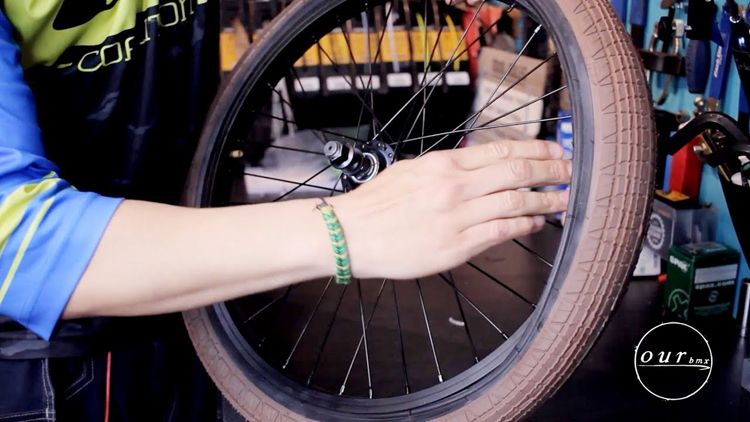 Replacing tubes and tires is a great skill to learn and will help you while riding out on the road.
Replacing tubes and tires is a great skill to learn and will help you while riding out on the road.
| Afraid to take off your rear wheel to fix a flat tire (or when taking off both wheels to put a bike in a car trunk)? Worried that you'll mess up the chain or shifting; or that you'll get all greasy? Think you'll never get the rear wheel back on right? We have good news: Anyone can remove and install a rear wheel and it won't affect the shifting or the chain. And if you work carefully, you won't have to touch that greasy drivetrain either. Here's how it's done on any bicycle with derailleurs, from road bikes, to mountain bikes and any 2-wheelers in between. Watch the videos and review the step-by-step photos and text. We're also happy to demonstrate in person, too, so please let us know if you'd like a quick lesson. We've covered all the tips and tricks, so you'll be an expert in no time! |
WHEEL REMOVAL 1, 2, 3!
1. Shift onto the small cog and small chainring.
Shifting the chain down onto the smallest cog on the rear wheel and the smallest chainring on the crankset, creates slack in the chain, which makes rear wheel removal much easier. It also makes wheel installation easier because it gives you an accurate way to line up the wheel (on the smallest cog) so that it slips right into the bicycle frame.
If you're riding and feel the rear tire becoming soft slowly from a puncture, you may have time to make the shifts to the smallest cog and ring as you're slowing to a stop.
If you're not riding, or have already stopped, operate the right shift lever, lift the bike by the seat and pedal by hand and the chain will move down the cogs in the back. Depending on the type of shift lever, you may need to move the lever a couple of times to move the chain onto the smallest cog.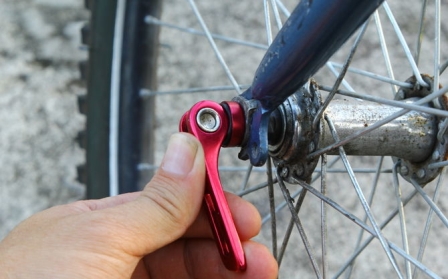
Now, do the same with the left shift lever and pedal by hand and get the chain onto the smallest chainring in front, too.
2. Open the brake
Note: If you're fixing a flat tire, you needn't worry about this step because when the air is all out of the tire it will fit through the brake easily. Also, if your bike has disc brakes, you too can skip this step because you don't need to touch disc brakes to remove wheels.
On most bikes with rim brakes, when you try to remove the wheel, the tire bumps into the brake pads. This is because the brake needs to be adjusted close to the rim, while the fully inflated tire is significantly wider than the rim.
To prevent the tire bumping into the brake pads, you can open sidepull brakes by fully rotating the little lever on the brake upwards (photo a). This little lever is called the brake quick release for the way it lets you quickly release (open) the brake pads. For linear-pulls (also called "direct-pulls," and "V-brakes") lift/pull the end of the "noodle" out of its holder (photo b).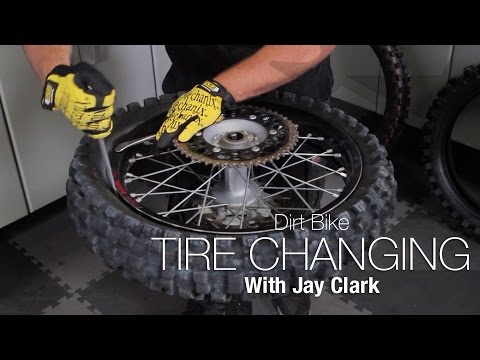
Some sidepulls are opened by pressing a button on the lever. Look for this if there's no lever on the brake.
Open cantilever brakes (these feature a cable that runs over the top of the tire) by lifting the cable end on one side out of its holder.
Workarounds: If you can't find a way to open a brake, you can also let air out of the tire until you can pinch it enough to squeeze it through the brake pads. Another trick - though it requires tools and time - is to remove one brake pad which will often provide sufficient clearance. If not, you can remove both pads. Just be sure to remount them carefully so that they contact the rim squarely and don't touch any part of the tire.
3. Pull the derailleur back and remove the wheel
Now you're ready to remove the wheel. Most bicycle wheels have quick releases holding them in the frame (the red parts in the photo). To open the quick release and loosen the wheel, simply pull and fully open the lever, which is usually on the opposite side of the chain. Don't twist the lever. Just pull it out/away from the frame.
Don't twist the lever. Just pull it out/away from the frame.
When the quick release is open, the wheel is ready to come out. To remove it, lift the bike by the seat so that gravity will help you. On some bikes the wheel will drop right out at this point (don't let it roll down the road and escape!). Or, if it doesn't fall out on its own, give it a slight blow with your hand and that might knock it right out.
Don't force anything though. If the wheel doesn't come out right away, it's because the derailleur and chain are blocking it. To get them out of the way, keep holding the rear end of your bike off the ground by lifting the bike by the seat. Reach down with your free hand and pull back the derailleur with your hand to get it, and the chain, out of the way.
Now, the wheel should fall out or drop out if you shake the bike. If the chain gets in the way still, just grip the wheel and shake it so that it's free of the chain and fully off the bike (that way you never touch the chain and stay clean).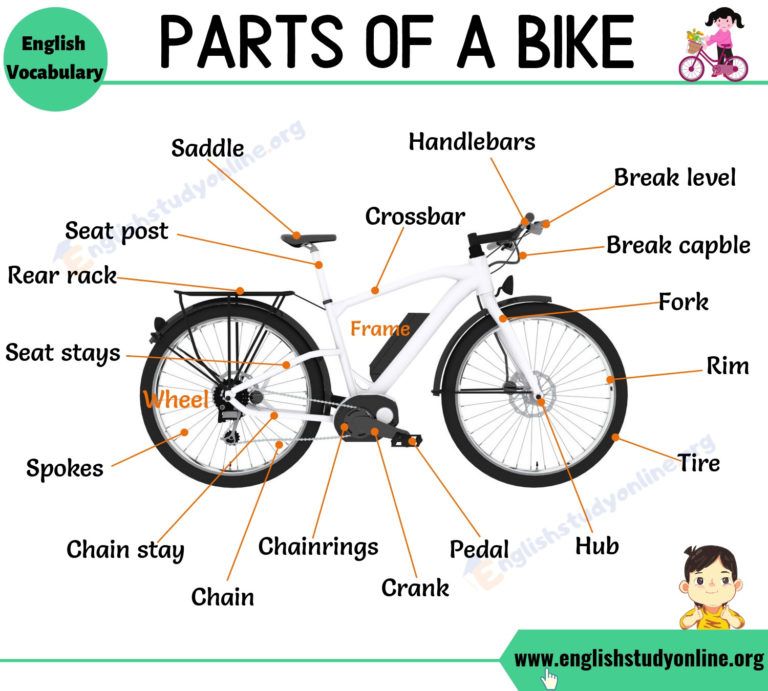 Good job!
Good job!
Note: To clearly show the desired derailleur position, we locked it in place. You must pull it back by hand when removing wheels because it won't stay in place on its own.
How to put the rear wheel back on
| As you guessed, installing the rear wheel is the same as removal only in the reverse order! You just place the wheel back in the frame being careful to get the chain on the right cog, close the quick release to lock the wheel in, and close the brake so your brakes are working again. The video shows front and rear wheel installation in that order. We go over the step-by-step below and explain some of the things that can go wrong and how to deal with them. It can be frustrating if the wheel won't go in easily. But there's always a mechanical reason. So, look at what you're doing carefully and read our instructions a few times and you should be able to find the problem and address it so that the rear wheels goes right back where it belongs. |
If your wheel won't go in easily, check these things:
Did you get the chain on the cog right? Remember that you shifted the chain onto the smallest rear cog before you removed the wheel. So, you must put the wheel back on by first lining that smallest cog up just right so that the chain is on it. Also, pay attention to how the chain rests on the cog. The chain is a closed loop. The cog should be inside the loop (see the photo in Step 3).
Note: If the wheel has been off the bicycle for some time, it's possible that someone might operate the shift levers. This can move the derailleur so that when you line up the wheel with the smallest cog the wheel won't go into the frame. Instead it bumps into the frame. To remedy this and get the wheel in, simply operate the shift lever as if you're shifting onto the smallest cog. This will move the rear derailleur back where it needs to be so that the wheel will line up right with the frame and go in.
This will move the rear derailleur back where it needs to be so that the wheel will line up right with the frame and go in.
Did the chain come off the derailleur pulley? Another glitch that can prevent the wheel going right into the frame is if the chain happens to come off the top pulley on the derailleur (photo). This is hard to see but it has a similar effect to someone shifting the derailleur into the wrong position and it makes the wheel run into the frame and not want to go in. To fix it, just push the chain back onto the pulley and make sure it stays there as you install the wheel. Tip: Use a stick to push it on or wrap your finger in a rag and you'll stay grease-free.
Is your quick release still open? Sometimes when the wheel is separate from the bike, the quick release lever gets bumped and flipped over and closed. When this happens the wheel won't fit in the frame anymore because the quick release is closed and in the way.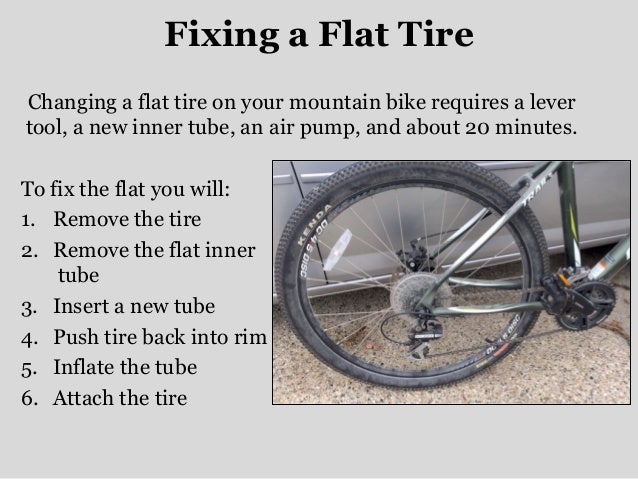 Open it and the wheel will fit.
Open it and the wheel will fit.
Now that you know how it's done, you may want to practice removing and installing your rear wheel a few times to become expert at it so that when you have to do it, it's a breeze. And, so you can dazzle your friends by helping them remove/install their wheels! Have fun and let us know if you'd like a demo.
There is nowhere without a bicycle in the country. In the truest sense of the word, there is nowhere to go. Not for bread, not for screws, not for matches. Also, if you don't have a car. And if there is a car, and the driver tasted fragrant apple calvados in the morning? You have to walk, which takes a lot of time. And if there is a bicycle, he jumped on it, and in a few minutes there would be bread, and screws bought, and matches mined. Therefore, not only must bicycle transport be at your disposal, but besides, it must always be in good order, ready at any time to deliver you on urgent matters.
While conducting a spring revision of my old high-speed bike, we found an "eight" on the rear wheel - a change in its geometry. The rim was bent so much that it constantly brushed against the brake pads, making it impossible to drive safely.
First, we decided to tighten the spokes. There are special ways to do this at home. For those who are interested, it is enough to search the Internet for how to fix the G8. Upon closer inspection, it was found that a pair of spokes was missing. The plastic protection of the spokes installed on the wheel makes it difficult to install new ones, so it must be completely disassembled.
Turn the bicycle upside down, unscrew the eccentric clamp nut, remove the eccentric itself from the hole in the axle, release the footrest, remove the chain and wheel. In this case, you need to loosen the brake pads and release air from the wheel so that the tire does not cling to them.
Unscrew the nipple, pull out one side of the tire, carefully prying it with a flat screwdriver, without tearing the chamber.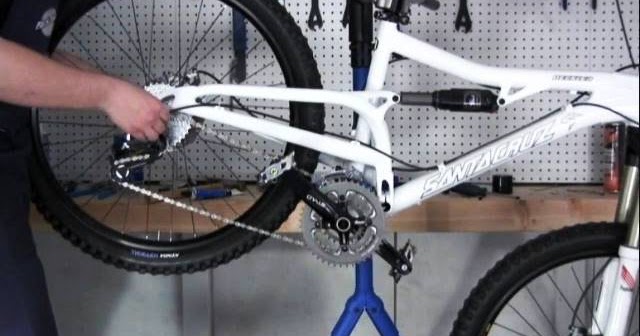 Get the camera, then remove the tire.
Get the camera, then remove the tire.
Now you need to remove the asterisk. It is impossible to do this without a special puller, so we took care of buying it in advance.
Insert the puller inside the sprocket and unscrew it with a gas wrench. By the way, any key for 24 can be suitable for these purposes.
Here another trouble was discovered - the rim was worn to the hole. Repair it was impossible, so I had to go to the store for a new one.
Our speed bike had a single rim wheel. Almost all modern cycle bikes are equipped with double rim wheels. It is believed that they are stronger and more reliable. The price difference is not very big, so we listened to the seller and bought a copy with a double rim.
At first, the plan for replacing a rear wheel on a speed bike seemed simple: screw the sprocket onto a new one, insert the tube, tire and install on the bike. But upon closer inspection, it turned out that the axles of the wheels are different. The old one has a hole inside for the eccentric, and the new one does not.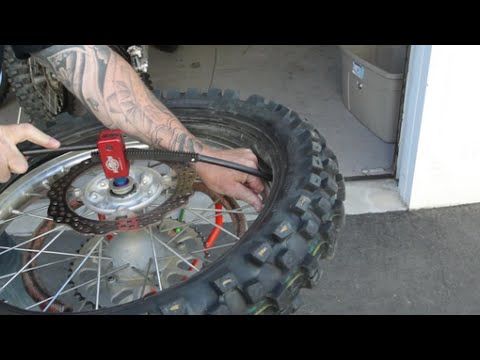
Therefore, I had to rearrange the axle from the old wheel to the new one. This requires 2 keys. We hold the locknut with one, and unscrew the second with the other. Having unscrewed, remove the washer and unscrew the lock nut, which is the bearing boot. While loosening the nut, watch out for balls that may fall out of the resulting gap. Now you can take out the axle.
In the same way, remove the axle from the new wheel. The grease in it is fresh, thick, so the bearing balls, having stuck to it, were in their place.
Carefully, adding fresh grease, insert the axle with the eccentric hole onto the new wheel and tighten the nuts in reverse order.
Tighten the bearing cone nuts until there is no play in the carriage, but at the same time the wheel rotates freely. On both sides of the axle, at the edges, we leave a space equal to 1 cm so that it fits into the lugs of the rear fork of the bicycle. This distance is adjusted by a washer in the form of a sleeve. Tightening the second nut, we fix the first one with a key so that it does not move, otherwise the wheel will spin with effort.
Then we assemble everything in the reverse order. We install the protection of the spokes, with the help of a puller we twist the sprocket.
Fill the tire on one side, insert the tube, fill the tire completely. We inflate the chamber with a pump, then bleed the air so that it falls into place.
Now we take the wheel, put the chain on the sprocket and install the axle in the fork lugs. The tire, pressing on it, must be inserted between the brake pads.
Install the footrest, insert the eccentric clamp and secure it with the nut.
Adjust the brakes by attaching the pads near the rim. We pump up the camera and do a test drive. This completes the replacement of the rear wheel of a sports bike. If you liked the article, share it on social networks.
Contents
The reasons for replacing a wheel can be very different - from frequent nail penetration or “snake bite” by the edge of the rim to updating the wheel and transferring the old proven tube to it. There is no difficulty in how to change the camera on a bicycle. Consider how to do this, and what you may need in the process.
There is no difficulty in how to change the camera on a bicycle. Consider how to do this, and what you may need in the process.
If we change the camera in "ideal" conditions, we already have a garage ready, a tool kit, a repair kit and a new camera. Unfortunately, not everything is always so “successful”. It may turn out that the camera burst on the street during a long race or even in competitions.
The simplest option is to carry the chamber and pump with you. Not every damage can be sealed, and the easiest way is to change the whole camera. The only negative of this kit is the weight and volume. The sealing kit is a small box, but the “spare tire” is already a serious piece of rubber that can get in the way in a small bag, if you have one at all.
Unfortunately, the condition of the roads and the general susceptibility of modern bikes to damage mean that you can't travel further than the city center without a spare bike tube or repair kit. What will be needed to replace in the minimum version?
What will be needed to replace in the minimum version?
With these tools, you can easily disassemble the rear wheel, remove the camera and install a new one in its place.
The repair kit is worth considering separately. Many never open it from the moment of purchase, but in fact you can assemble it yourself. Homemade repair kit comes out several times cheaper.
What is in the repair kit?

Actually, all parts of the repair kit can be assembled by yourself. Old cameras are used for patches, cleaning is done with ordinary sandpaper, glue is sold in any store, and ordinary alcohol is a degreaser.
Recently, some people use anti-puncture gels, and it is enough to pour sealant into a new chamber before pumping it up and carefully “disperse” it along the inner cavity of the chamber.
Repair kit with beading, but without glue
Those who have changed the tube with their own hands know, perhaps, the main problem is the bending of the tire bead. Modern tires adhere so well to the rim and are so stiff that it is not always possible to do this by hand.
That's why many multi-tools or kits include a break-down. These are small plastic or metal "spoons" that are inserted between the tire and rim, allowing you to pry and bend the tire, and then put it back on.
So, what are the steps to follow to change the camera. Everything is simple, the main thing is accuracy and a small amount of physical strength.
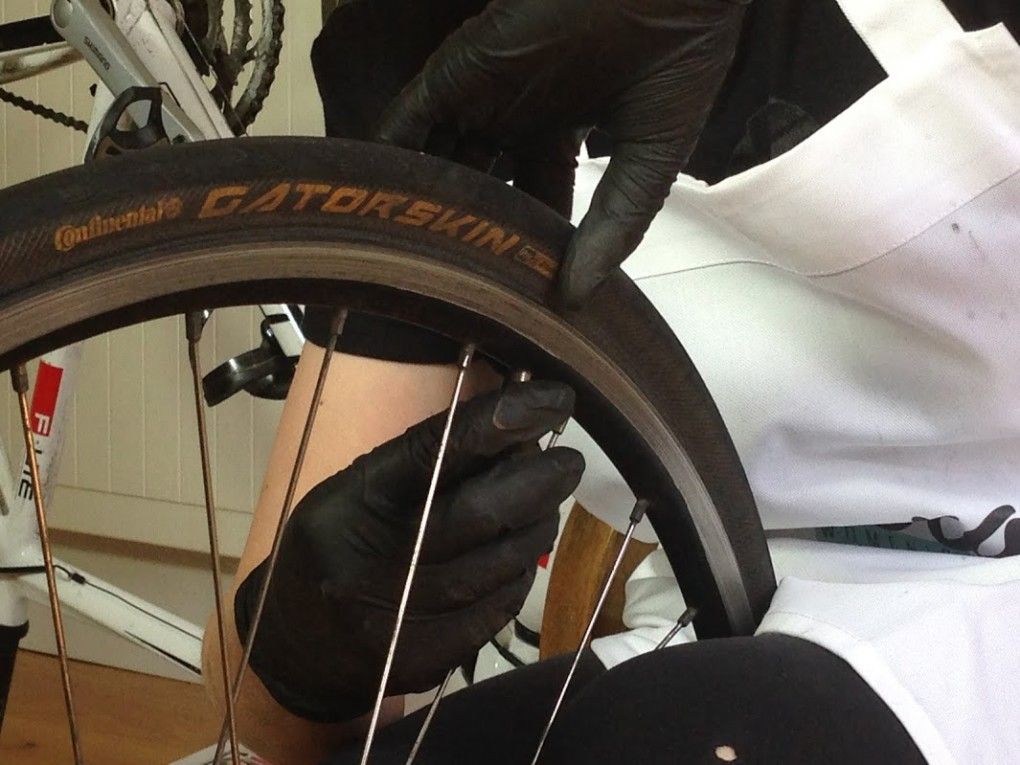
So, the camera is removed, you can repair it or print a new one. Installing everything back:
That's it, the replacement is done! As you can see, there is nothing complicated in this process.
Tube replacement is a simple process that every cyclist should be prepared for. A puncture on the road, damage to the camera in the forest, or just updating a bicycle wheel - it's always nice to deal with the problem yourself and quickly, and not carry the bike on yourself to the workshop.